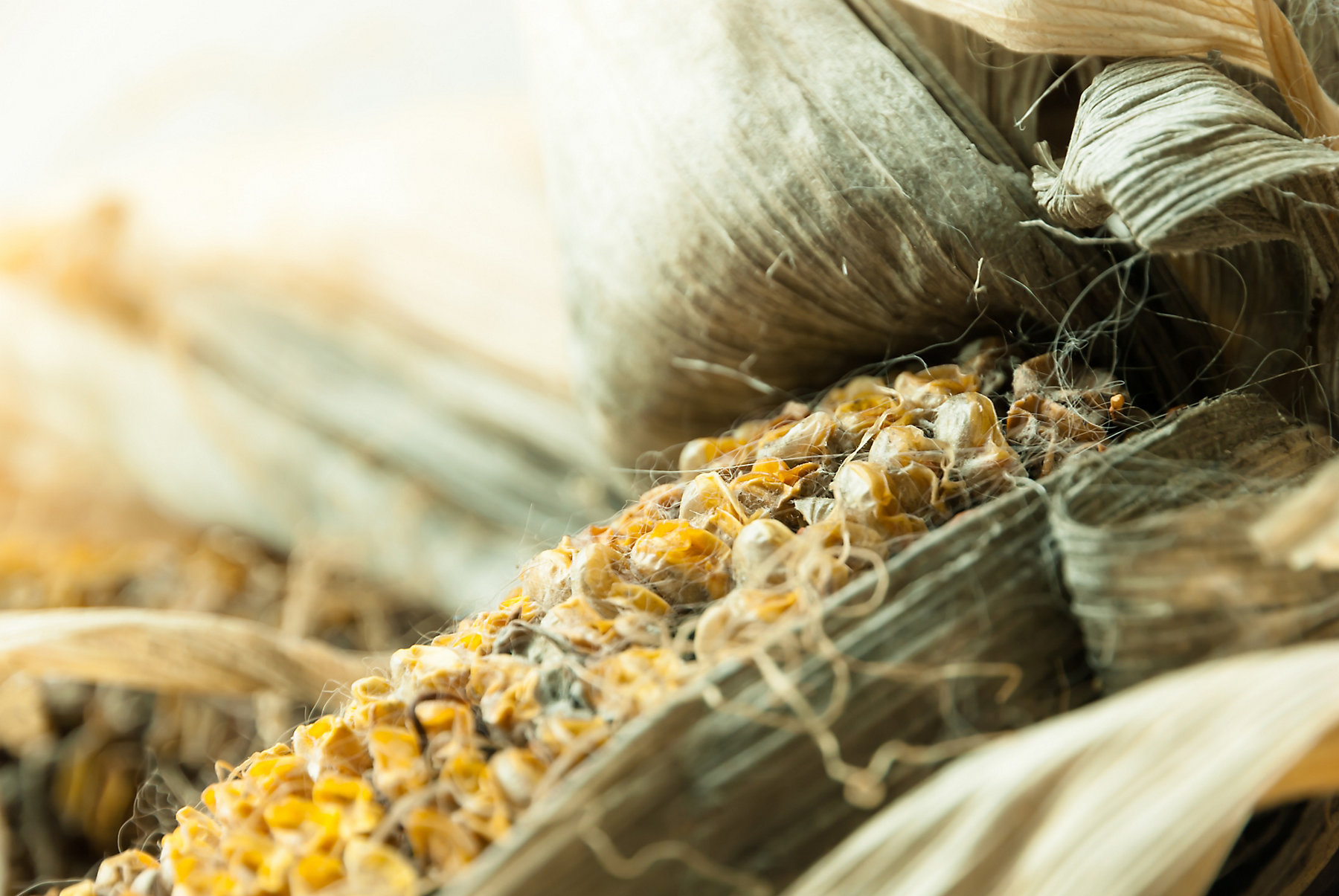The following chart was derived from various sources and shows some of the major mycotoxins produced by each of the three toxigenic fungi. This is not intended to be an all-inclusive chart, but is intended to show the wide variety of mycotoxins produced by a small number of molds.
Fungal Genera
|
Mycotoxin Produced
|
Aspergillus
|
Aflatoxin, Ochratoxin, Sterigmatocytsin, Fumitremorgens, Fumitoxins, Fumigaclavines, Cyclopiazonic Acid, Gliotoxin.
|
Fusarium
|
Deoxynivalenol, Zearalenone, T-2 Toxin, Fumonisin, Moniliformin, Nivalenol, Diacetoxyscirpenol, Neosolaniol, Fusaric Acid, Fusarochromanone, Fusarin C, Fusaproliferin, Beauvericin, Enniatins.
|
Penicillium
|
Ochratoxin, PR Toxin, Patulin, Penicillic Acid, Citrinin, Penetrem, Cyclopiazonic Acid, Roquefortine, Fumigaclavine C, Mycophenolic Acid, Wortmannin.
|
The bolded mycotoxins are the toxins generally recognized as having the biggest impact on livestock and poultry species. Much has been written about the impact each of these mycotoxins can have on health and performance.
Once we have mycotoxins in our crop, what options exist for livestock and poultry producers? Because most of the grain used to feed animals in the USA is not grown by livestock or poultry producers, these producers “inherit” the mycotoxins formed during the growing season and need strategies to deal with these mycotoxins.
One management consideration is to avoid forming more mycotoxins. Storage mold, just like field mold, can produce mycotoxins. Be sure to clean old corn from storage facilities before introducing new corn. Remove grain from the side of storage bins, clean out grain dust and sweep all flat surfaces to remove any source of mold spores. If the bin had moldy grain prior to the current load, use a spray disinfectant on all inside surfaces. The University of Nebraska-Lincoln Extension4 shares the following sanitation practice:
- An effective disinfectant mix for fungal contamination on non-porous surfaces like grain bins is 1/2 gallon of household bleach to 10 gallons of water.
- Wait several days and then rinse the area where the mixture was applied.
- Chlorine vapors are dangerous. Have plenty of ventilation when working in the bin and never mix bleach with ammonia or vinegar!
The use of mold inhibitors is a very common management practice and will help control the growth of storage mold. It is important to remember, once mold has damaged corn or mycotoxins are formed, mold inhibitors will not reverse these problems. Organic acid blends have been shown to effectively control the growth of mold when applied to grain. Dixon and Hamilton studied the effects of propionic, acetic, sorbic and benzoic acids as mold inhibitors.5 Kemin manufactures Myco CURB® Liquid and Myco CURB® Dry – two multi-acid mold inhibitors – designed specifically to control the growth of mold in grain, feed and feed ingredients.
A second consideration is to get the corn dry as quickly as possible. For livestock and poultry producers buying corn in the spring, most corn arrives at well below 14% moisture. However, in the fall, corn with over 15% is common. The shelf-life of corn is about twice as long at 14% versus 15% moisture when at the same temperature.4 There are several guides available to help determine the air flow needs and moisture content based on relative humidity, but the easiest way to remove moisture from grain is with moving air. Solar radiation can cause moisture migration as the south sides of metal bins heat up on sunny days. Running aeration fans weekly can help remove moisture pockets created by daytime heating and nighttime cooling.
Cool the grain and keep the grain cool during the winter. Aeration, along with removing moisture, can cool grain. The eventual goal in northern climates is to cool grain to less than 30 °F (-5 °C). In southern climates, it is not often possible to cool grain to this level, so aerate to cool grain whenever grain temperature is 10 °F (6 °C) higher than air temp.4
Once the mycotoxin is formed, what can producers do to minimize the impact on animal health and performance? A strategy used for many years is the idea of decontaminating the feed by sequestering the mycotoxin. This practice of removal or neutralization of mycotoxins is used by incorporating flow agents with demonstrated efficacy in controlled university and independent research.6,7 In-vitro evaluation has shown the following classes of compounds have good efficacy at sequestering these metabolites2:
- Activated charcoal
- Montmorillonite/Bentonite
- Zeolite
- Hydrated sodium calcium aluminosilicates (HSCAS)
- Yeast cell wall-derived agents
Livestock and poultry producers have several strategies they can employ to help reduce mycotoxin formation in stored grain. Once the mycotoxins are formed, options are limited, but scientific studies have shown efficacy from compounds demonstrated to sequester mycotoxins.
References
1Harper, Douglas. "myco" and “toxin”. Online Etymology Dictionary.
2Diaz, D. E. (Editor) 2005. The Mycotoxin Blue Book Nottingham University Press.
3Sweeney, M. J. and A. D. W. Dobson. 1998. Mycotoxin production by Aspergillus, Fusarium and Penicillium species. Intern. J. Food Microbiol. 43:141-158.
4Dorn, T. W. 2012. Grain Storage Management to Minimize Mold & Mycotoxins. University of Nebraska-Lincoln Extension. Found on November 16, 2018, at https://cropwatch.unl.edu/documents/UNL-Grain-Quality-2012-10-4-2012-Dorn.pdf.
5Dixon, R. C. and P. B. Hamilton. 1981. Effect of food ingredients on the antifungal activity of propionic acid. Poult. Sci. 60:2407-2411.
6Ramos, A. J., J. Fink-Gremmels, and E. Hernández. 1996. Prevention of toxic effects of mycotoxins by means of nonnutritive adsorbent compounds. J. Food Protection. 59(6):631-641.
7Vila-Donat, P., S. Marín, V. Sanchis, and A. J. Ramos. 2018. A review of the mycotoxin adsorbing agents, with an emphasis on their multi-binding capacity, for animal feed decontamination. Food and Chemical Toxicology. 114:246-259.

